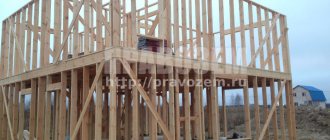Recognition by the court of ownership of unauthorized construction in 2021
Content
Features of obtaining ownership rights to unauthorized objects 2. Recognition of the right to unauthorized construction: judicial practice 3. Video instructions “How to legalize unauthorized construction”
In order to have the right to demand recognition in court of ownership of an unauthorized construction, you first need to decide that it is possible name.
An unauthorized construction is a construction project erected without official permits, without complying with all building codes and regulations on a land plot that is not actually intended for construction and is considered unsuitable.
Usually, most unauthorized buildings are demolished, but you can try through the court to register this construction project as private property. The process of recognizing ownership of an unauthorized construction can only be carried out through a court.
Want to win a quote request? Take advantage of our achievements! We will help you win at least a third of the quotes!
Win Quote
Features of obtaining ownership rights to unauthorized objects
The court has the right to recognize and transfer ownership of unauthorized buildings only to those persons who actually and legally own the land plot where the building is erected. A positive decision will be made if the land is a lifelong or inherited property, or is in constant, indefinite use.
The court has the power to refuse registration of property rights in cases where the applicant:
- not the owner of the land:
— rents the land on which the object is located;
- subtenant of a land plot with unauthorized construction;
- uses the land free of charge for a certain period of time.
Conditions for recognizing the ownership of a joint venture
To recognize ownership of an unauthorized structure, the following conditions must be present:
1) The object has signs of immovable ownership.
2) Organizing the construction of an object without permission will occur in violation of construction requirements.
3) An unauthorized construction facility does not violate the boundaries and rights of other entities.
4) The building meets safety requirements.
5) The applicant is the owner of the land plot.
6) The building was broken by the applicant or at his expense.
7) There is no legal owner of the building.
Do you want to enter into direct contracts without a tender? For you - the largest database of subcontracts and commercial orders that you can receive as a result of regular negotiations!
Get a free selection of direct commercial contracts
Recognition of the right to unauthorized construction: judicial practice
In the event that the plaintiff is not the owner of the land plot on which the unauthorized facility is located, but has invested his own funds in its construction, there are several ways to register ownership.
1) Buy a land plot: only a subject who is the legal owner of real estate on this land, of which at least one must be legally correctly registered and registered, is entitled to do this.
2) If the land plot where the unauthorized constructed object is located belongs to another object by right of ownership, the applicant who organized the construction may demand to purchase this plot or recover from the owner the costs of constructing the structure.
In a situation where the owner of the land on which the building is located does not agree to satisfy the applicant’s demands, the unauthorized object will be demolished.
Do you want to participate in tenders with an advance payment from the customer? For you - the most complete database of government and commercial tenders with advance payment from 30% to 100%!
Conclude a contract with advance payment
Video instruction “How to legalize unauthorized construction”
Back to list
Video on the topic
In connection with the adoption of the new edition of Article 222 of the Civil Code of the Russian Federation, there are still more questions than answers regarding judicial practice on the recognition of ownership of an unauthorized building and regarding its demolition . In addition, the courts do not yet know how to apply the new article themselves. Let's try to figure out what happened and what happened.
What happened to the self-construction?
According to Article 222 in the old version, an unauthorized building is a residential building, other building, structure or other real estate created on a land plot that is not allocated for these purposes in the manner established by law and other legal acts, or created without obtaining the necessary permits or with a significant violation of town planning and building codes and regulations. A person who has carried out an unauthorized construction does not acquire ownership rights to it. It does not have the right to dispose of the construction - sell, donate, lease, or make other transactions. An unauthorized building is subject to demolition by the person who carried it out or at his expense, except for the cases provided for in paragraph 3 of this article.
The right of ownership of an unauthorized construction may be recognized by the court, and in cases provided for by law in another manner established by law, for the person who owns, has lifetime inheritable possession, and whose permanent (perpetual) use is the land plot where the construction was carried out. In this case, the person whose ownership of the building has been recognized shall reimburse the person who carried it out for the costs of construction in the amount determined by the court. The right of ownership of an unauthorized structure cannot be recognized for the specified person if the preservation of the structure violates the rights and interests protected by law of other persons or creates a threat to the life and health of citizens.
Thus, based on the norms of this article, two types of claims can be distinguished:
- protection of the owner of the land plot;
- owner of the unauthorized construction.
According to the joint resolution of the Plenum of the Supreme Arbitration Court and the Supreme Court of the Russian Federation No. 10/22 dated April 29, 2010 “On some issues arising in judicial practice when resolving disputes related to the protection of property rights and other property rights” (hereinafter referred to as Resolution No. 10/22) we can highlight two methods of protection for recognition of ownership of an unauthorized building and for the demolition of an unauthorized building and its demolition.
How we understood the recognition of property rights in court according to the old version and the resolution of the Plenum: In accordance with paragraph 25 of the resolution, the ownership right to an unauthorized construction can be recognized by the court for a person in the ownership, lifelong inheritable possession, whose permanent (perpetual) use is the land plot , where the construction was carried out (hereinafter referred to as the legal holder of the land plot). If an unauthorized construction is carried out on a land plot that does not belong to the developer, but the necessary permits for its creation have been obtained, the owner of the land plot has the right to file a claim for recognition of ownership of the unauthorized construction. The defendant in such a claim is the developer. In this case, the developer has the right to demand reimbursement of construction costs from the copyright holder. If an unauthorized construction is carried out on a land plot owned by the developer, but the necessary permits for its creation have not been obtained, the defendant in the developer’s claim for recognition of ownership of the unauthorized construction is the local government body on whose territory the unauthorized construction is located (in the federal cities of Moscow or St. Petersburg is an authorized state body of the federal cities of Moscow or St. Petersburg).
Thus, following the logic of Plenum Resolution No. 10/22, there are two cases of filing a claim in court to recognize ownership of an unauthorized construction: a claim by the owner of a land plot against the developer and a claim by the developer of an unauthorized construction against an authorized local government body. As a general rule, a person who has carried out an unauthorized construction does not acquire ownership of it and does not have the right to dispose of it (sell, donate, lease, or make other transactions). In accordance with current legislation, such a building is subject to demolition (clause 2 of Article 222 of the Civil Code of the Russian Federation).
Following established judicial practice, ownership of an unauthorized construction can be recognized for a person, but only if there are the following grounds:
- ownership of a land plot by a person;
- no threat to the life and health of citizens;
- no violation of the rights and legitimate interests of other persons;
- the presence of attempts to legalize the construction - for example, attempts to obtain a construction permit and/or an act of putting the facility into operation (clause 3 of Article 222 of the Civil Code of the Russian Federation, clause 26 of the Resolution of the Plenum of the Armed Forces of the Russian Federation and the Plenum of the Supreme Arbitration Court of the Russian Federation dated April 29, 2010 No. 10/ 22).
What happened to the self-construction?
Now let’s look at how to correlate with Plenum Resolution No. 10/22 the conditions for recognizing the right of ownership of unauthorized construction (self-construction) in accordance with the new wording of Article 222 of the Civil Code of the Russian Federation. In accordance with paragraph 3 of Art. 222 of the Civil Code of the Russian Federation , the right of ownership of an unauthorized structure may be recognized by the court , and in cases provided for by law in another manner established by law, for the person in ownership, lifelong inheritable possession, permanent (perpetual) use of which is the land plot on which the building was created, with simultaneous compliance with the following conditions: if in relation to the land plot the person who carried out the construction has rights allowing the construction of this object on it; if on the day of going to court the building complies with the parameters established by the territory planning documentation, land use and development rules or mandatory requirements for building parameters contained in other documents; if the preservation of the building does not violate the rights and legally protected interests of other persons and does not create a threat to the life and health of citizens.
Having analyzed these conditions, we can come to the conclusion that the legislator partially took these conditions for recognizing property rights from Resolution No. 10/22 and from established judicial practice in these disputes.
It is important to note that the legislator indicated that in order to recognize the ownership of an unauthorized construction, it is necessary to simultaneously comply with all of the above conditions , and not at least one, which significantly complicates the work of practicing lawyers.
The first condition “if in relation to the land plot the person who carried out the construction has rights allowing the construction of this object on it” is interpreted as the intended purpose of the land plot, that is, if the object that was erected corresponds to the original purposes of providing the land.
The second condition “if on the day of going to court the building complies with the parameters established by the territory planning documentation, land use and development rules or mandatory requirements for building parameters contained in other documents” means that the erected building must comply with the territory planning project on this land plot ( which may not be accepted), land use and development rules (most often adopted), and the construction must comply with the type of permitted use of the land (Definition of the RF Armed Forces dated September 25, 2014 in case No. A65-6880/2013).
The third condition “if the preservation of the building does not violate the rights and legally protected interests of other persons and does not create a threat to the life and health of citizens” is a condition that has already been in judicial practice and which had to be proven in court through a forensic construction and technical examination. Thus, the legislator has significantly complicated the recognition of ownership of unauthorized buildings in court, because in practice, most often unauthorized buildings are erected on land plots, the type of permitted use of which does not correlate with the unauthorized buildings erected on them, and also complicated the third condition regarding the project territory planning and land use and development rules.
The legislator has made it practically impossible to recognize the right of ownership of an unauthorized construction in court. In addition, it should be noted that one of the conditions for recognition of property rights “compliance with appropriate measures for legalization”, indicated by the resolutions of the Plenums of the Supreme Arbitration Court of the Russian Federation, the Supreme Court of the Russian Federation No. 10/22, paragraph 9 of the Information Letter of the Presidium of the Armed Forces of the Russian Federation dated December 09, 2010 No. 143, has not been added to the new edition of Article 222 of the Civil Code of the Russian Federation. Accordingly, we can conclude that this fact of applying pre-trial to the body exercising state construction supervision for a construction permit, and subsequently for the commissioning act, is now not included in the subject of proof in this category of cases? The answer to this question has not yet been given by the clarifications of the Supreme Court of the Russian Federation.
Now let’s consider this method of protecting the owner of a land plot, such as filing a claim for the demolition of an unauthorized building .
How it was?
According to paragraph 22 of the above-mentioned resolution of the Plenum No. 10/22, the owner of a land plot, the subject of other property rights to a land plot, its legal owner or a person whose rights and legitimate interests are violated by the preservation of an unauthorized building, has the right to apply to the court according to the general rules of jurisdiction of cases with a claim about the demolition of an unauthorized building. Within the meaning of paragraph two of paragraph 2 of Article 222 of the Civil Code of the Russian Federation, the defendant in a claim for the demolition of an unauthorized building is the person who carried out the unauthorized construction. When creating an unauthorized structure with the involvement of contractors, the defendant is the customer as the person on whose instructions the unauthorized construction was carried out.
Grounds for demolition of unauthorized construction (samostroy) in court:
- construction on a land plot not provided for these purposes;
- significant violation of town planning and building codes and regulations;
- lack of a construction/reconstruction permit and/or commissioning certificate;
- threat to the lives and health of citizens.
What was the procedure for the demolition of unauthorized buildings on the territory of the city of Moscow according to the Moscow Government Resolution No. 819-PP dated December 11, 2013 “On approval of the Regulations on the interaction of executive authorities of the city of Moscow when organizing work to identify and suppress illegal (mis)use of land plots”? If ownership of a building that has signs of unauthorized construction has not been registered, it is subject to demolition without a court decision by the prefecture of the relevant district as soon as possible after its discovery. If the ownership right is registered for an unauthorized building, then a claim is brought against the person who erected it to demolish the unauthorized building and exclude information from the Unified State Register (if the object is capital) or to recognize the ownership right as absent and to vacate the land plot (if the object is not capital) . Thus, no one could be deprived of ownership of the property without a court decision.
What happened?
With the adoption of paragraph 4 of Article 222 of the Civil Code of the Russian Federation, it is not clear how executive authorities should behave.
Let's consider the contradictions between the Government resolution and the new provisions of the article. Due to the fact that the Federal Law has greater legal force than the regulatory legal act of the Moscow Government. Thus, in the event of a conflict, it is necessary to be guided by the Federal Law, that is, the new norms of Article 222 of the Civil Code of the Russian Federation. According to paragraph 4 of Art. 222 of the Civil Code of the Russian Federation, local government bodies of a city district (municipal district if an unauthorized building is located on an intersettlement territory) have the right to make a decision on the demolition of an unauthorized building if it is created or erected on a land plot not provided in the prescribed manner for these purposes, if this the land plot is located in a zone with special conditions for the use of territories (with the exception of the zone for the protection of cultural heritage sites (historical and cultural monuments) of the peoples of the Russian Federation) or on public territory or in the right of way of utility networks of federal, regional or local significance. In the following, the article describes the procedure for demolishing an unauthorized building according to the following scheme (Table 1). Thus, the deadlines for demolition and making a decision that the building is unauthorized in the new edition (7 days for making a decision, 7 days for publication, 2 months for demolition) differ from the deadlines specified in Resolution No. 819-PP. Also, the legislator did not indicate what the executive authorities should do if ownership of an object with signs of unauthorized construction is registered and what is the procedure for its demolition. Table 1. Previous news Next news




